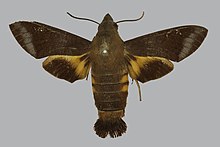Macroglossum glaucoptera
Macroglossum glaucoptera, the dark hummingbird hawkmoth, is a moth of the family Sphingidae. It was described by Arthur Gardiner Butler in 1875. It is known from Sri Lanka, Thailand, southern China, Vietnam, Malaysia (Peninsular), Indonesia (Sumatra, Java) and the Philippines (Mindanao).[4] Single specimen recorded from Papua New Guinea.[5]
| Dark hummingbird hawkmoth | |
|---|---|
 | |
| Scientific classification | |
| Kingdom: | Animalia |
| Phylum: | Arthropoda |
| Class: | Insecta |
| Order: | Lepidoptera |
| Family: | Sphingidae |
| Genus: | Macroglossum |
| Species: | M. glaucoptera |
| Binomial name | |
| Macroglossum glaucoptera | |
| Synonyms | |
Description
The wingspan is 52–54 mm. The upperside of the body is yellowish green with a blackish-brown fantail with no grey band between the lines. The forewing upperside is blackish brown. Hindwings are with a yellow band very narrow. Head is dark greyish, thorax and abdomen are brightly rufus. Abdomen has yellow and black lateral markings on anterior segments. The anal tuft is black with a rufus tip. In the female, the thorax and abdomen are olivaceus. Forewings not quite as dark as in the male. Hindwings have a broad band.[6]
Adults are attracted to the flowers of Duranta erecta. Caterpillars are found on Memecyclon scutellatum.
References
- "CATE Creating a Taxonomic eScience - Sphingidae". Cate-sphingidae.org. Archived from the original on 2012-10-01. Retrieved 2011-10-25.
- "CATE Creating a Taxonomic eScience - Sphingidae". Cate-sphingidae.org. Archived from the original on 2012-10-01. Retrieved 2011-10-25.
- "CATE Creating a Taxonomic eScience - Sphingidae". Cate-sphingidae.org. Archived from the original on 2012-10-03. Retrieved 2011-10-25.
- Pittaway, A. R.; Kitching, I. J. "Macroglossum glaucoptera Butler, 1875 -- Dark hummingbird hawkmoth". Sphingidae of the Eastern Palaearctic. Retrieved December 15, 2018.
- "The Hawkmoths (Sphingidae, Macroglossinae) of Papua Indonesia". The Papua Insects Foundation. Retrieved 8 July 2016.
- Hampson, G. F. (1892). The Fauna of British India, Including Ceylon and Burma: Moths Volume I. Taylor and Francis – via Biodiversity Heritage Library.